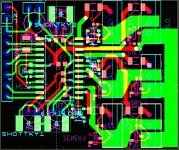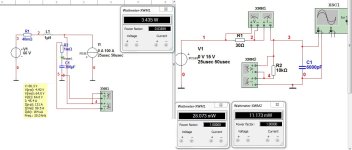rhitee05 said:
Look, I don't want to
come on too strong here and you're welcome to do whatever you want... but you might try doing a little more reading because most of what you've been saying is pretty far wrong. Even if you insist on ignoring everything I have to say hopefully I can at least put up a flag for other newbies to ignore this thread until you learn what you're talking about. No offense intended
Teh Stork said:
Motor inductance have everything to say for the inductance of the battery pack. Low voltage ripple = battery inductance path dealt with.
This doesn't make any sense. Motor inductance and battery inductance have NOTHING to do with each other.
Are you trying to say that if I switch to a different motor without changing anything else the inductance between the battery and controller will be different? You also have the cause and effect backwards - battery inductance causes voltage ripple.
Sorry, the bolded part does not make any sense. Neither does "except for the minor point that motor inductance has minimal-to-zero effect on the ripple voltage/current.". I was trying to respond to that, but failed. Blue part: no, I'm not saying that. Red part: Absolutely not. Current ripple (created by PWM!) CAUSES voltage ripple. The capacitor smooths the voltage from the battery. The voltage ripple is greatest at 50% pwm. ΔV0.5t = Vbus / (32 ∗ L∗ C ∗ f^2 ) can be used to predict the voltage ripple. Choosing a low inductance capacitor here is of great importance.
rhitee05 said:
Teh Stork said:
Why do I say inductance and not ESR? Well, ESR have many measuring modes, often measured at 1kHz. Our useage, at 20kHz, makes such ratings useless if the inductive portion of the ESR (at 1kHz) is high).
ESR is completely separate from inductance - that's what ESL is for.
ESL is often factored in in these ESR measurements, so you need to be careful while choosing capacitors. Was just trying to point out going for a low ESR cap might be a bad choice.
rhitee05 said:
Teh Stork said:
What you are talking about, stray inductance, is best dealt with by other methods.
1. Keeping motor leads together, making the magnetic field collapse into themselves instead of through the mosfets.
Keeping the motor leads close together will reduce their inductance, but a relatively small contribution compared to the inductance of the motor itself. And unimportant.
No, you've got this totally wrong. Motor inductance is stored in materials with magnetic properties, this is like syrup compared to the magnetic field around the phase wires! The inductance from the phase wires will make a inductive spike once the mosfet turns off - and the mosfet will need to block/clamp it. To say it in other words: the time constant of the phase wire inductors is significantly less than of the motor stator.
rhitee05 said:
Teh Stork said:
2. The mosfets WILL be subjected to repeated pulses (avalanche rating (mosfet working as a diode)). Mosfets need to be sized to handle these!
The MOSFETs will not be subjected to avalanche unless you're doing something really, really, horribly wrong. The voltage ripple and/or spikes which will be seen in a controller are NOT avalanche.
Firstly, I want to correct myself. The mosfet is working as a zener diode - not a diode. The mosfet will be clamping spikes every now and then, (i might have gotten this wrong -->), the avalanche rating is there to say how big this pulse can be before normal operation (the mosfet can start conducting f.ex) is disturbed.
rhitee05 said:
Teh Stork said:
I'm not parallelling fets - since I know the extreme measures needed to protect these. Single fets aren't as hard

MOSFETs parallel very well and this is done very, very often.
They are, but for a hobbyist going for single fets is easier. I hope to be able to parallell whole power boards in the future - as this board only have mosfet driver and mosfets. Current sense will have it's own board, and uC will have its own.
rhitee05 said:
Teh Stork said:
3. Smart driver features: shoot through protection, turn on delay, turn off delay - you name it.
These features have nothing really much to do with stray inductance.
I agree. But then again, you can tie stray inductance to nearly everything.
rhitee05 said:
Teh Stork said:
stray inductance (x resistance =voltage)
????
Just wanted to add the whole sentence for context.
"4. Fall time. Fall time. Fall time. Fall time. SO much depend on this and wheter stray inductance gets the better of you.
If stray inductance (x resistance =voltage) beats diode recovery: buh-bye mosfet"
Yeah, I agree that the bolded part is wrong. Should say something like: if Voltage/fall time exceeds diode recovery - problems occur. And that induced voltage = inductance*change of current/fall time. Just want to point out that motor inductance is neglitiable and phase wire inductance is the dangerous one here.
rhitee05 said:
Teh Stork said:
We don't have any freewheeling mosfets in our 3-phase inverters!
Huh?
Well, we're supposed to switch to the next phase in our bridge. And I was referring to the info in that document.
rhitee05 said:
Teh Stork said:
A small capacitor inbetween phase wires can reduce this pulse some.
All a capacitor between phases is going to do is dissipate energy in the ESR.
No, it will reduce some of the inductive spike from the phase wires. When the cap is charged - no current is flowing, and none is lost to ESR.
Sorry for my previous post containing these mistakes, you were right to raise the "newb flag". Then again, many of your points are flawed too - i hope the further discussion won't be too colored from this.




